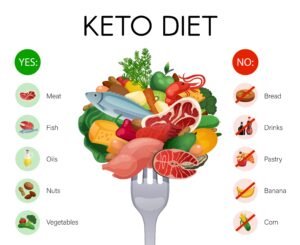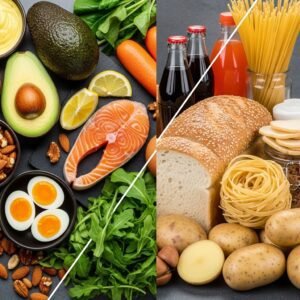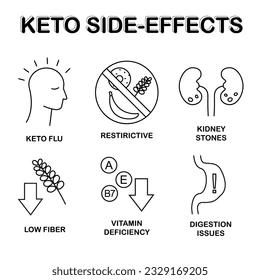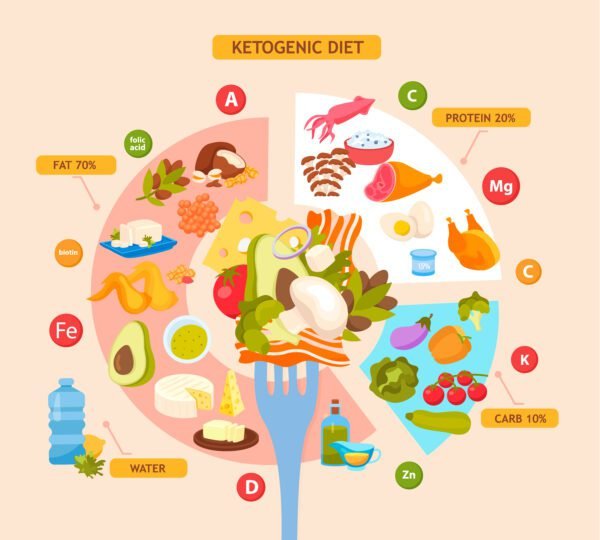The ketogenic, or keto, diet has exploded in popularity, captivating countless individuals searching for effective fat loss strategies. You’ve likely heard the buzz: promises of rapid weight reduction, increased energy, and a metabolic shift that turns your body into a fat-burning machine. But what exactly is the keto diet, and how does it deliver on these claims?
At its core, the keto diet is a very low-carbohydrate, high-fat, and moderate-protein eating plan designed to usher your body into a unique metabolic state called ketosis. Instead of relying on glucose from carbohydrates for energy, your body learns to burn fat, producing compounds called ketones as an alternative fuel source. This article will demystify the keto diet, explain its mechanisms for fat loss, cover its potential benefits and downsides, and provide practical advice for anyone considering this popular approach to burning fat through ketosis.
What is the Ketogenic Diet? The Science Behind It
To truly understand how the keto diet works its fat-burning magic, we first need to delve into its fundamental structure and the fascinating metabolic shift it aims to achieve. This isn’t just another diet; it’s a specific manipulation of your macronutrient intake designed to change your body’s primary fuel source.
Macronutrient Ratios: The Keto Blueprint

The most defining characteristic of the ketogenic diet lies in its unique macronutrient ratios. Unlike typical diets that often emphasize carbohydrates, keto drastically flips the script. While exact percentages can vary slightly, a standard ketogenic diet typically comprises:
- 70-75% of calories from fat: This is the dominant macronutrient, providing the primary fuel source.
- 20-25% of calories from protein: Protein intake is moderate, enough to preserve muscle mass but not so high that it inhibits ketosis (a process called gluconeogenesis can convert excess protein into glucose).
- 5-10% of calories from carbohydrates: This is the critical, very strict limit, typically amounting to less than 20-50 grams of net carbs per day. (Net carbs are total carbs minus fiber, as fiber isn’t digested and doesn’t impact blood sugar.)
This precise balancing act is crucial for triggering the body’s metabolic transformation.
The Goal: Ketosis
The ultimate aim of adhering to these strict macronutrient ratios is to achieve a state called ketosis. Normally, your body prefers to run on glucose, which it gets from breaking down carbohydrates. When you drastically reduce carbohydrate intake, however, your body’s glucose stores (glycogen) become depleted.
In response to this carbohydrate scarcity, your liver steps up to the plate. It begins breaking down stored fat into molecules called ketone bodies (primarily beta-hydroxybutyrate, acetoacetate, and acetone). These ketones then become the body’s primary alternative fuel source, powering everything from your muscles to your brain. It’s a survival mechanism that our ancestors relied upon during periods of food scarcity.
Metabolic Shift: From Sugar Burner to Fat Burner
Think of your body as a hybrid car that usually runs on petrol (glucose). By consistently depriving it of petrol, you force it to switch to its alternative fuel source: electricity (fat and ketones). This metabolic adaptation is profound. Instead of readily burning the carbohydrates you consume, your body becomes incredibly efficient at tapping into its own fat reserves – both dietary fat and stored body fat – for energy. This fundamental shift from being a “sugar burner” to a “fat burner” is precisely why the ketogenic diet holds such promise for those looking to shed excess pounds.
How Keto Promotes Fat Loss
Now that we understand the metabolic shift into ketosis, the burning question remains: how exactly does this state translate into effective fat loss? The ketogenic diet isn’t just about cutting carbs; it leverages several powerful mechanisms that directly contribute to shedding unwanted body fat.
Increased Fat Oxidation: Your Body’s New Fuel Preference
Once your body is in a state of ketosis, its primary fuel source shifts from carbohydrates to fat. This means your body becomes incredibly efficient at fat oxidation – the process of breaking down fat for energy. When you’re consistently consuming high amounts of healthy fats and very few carbs, your body is primed to tap into both the dietary fat you consume and, crucially, your stored body fat for fuel. This direct reliance on fat for energy is the most fundamental way keto promotes fat loss. You’re literally burning fat to live and move.
Appetite Suppression & Satiety: Taming the Hunger Monster
One of the most frequently reported benefits of the keto diet is its profound effect on appetite. The high fat content of the diet, combined with moderate protein, contributes significantly to satiety – that feeling of fullness and satisfaction after a meal. Fats digest more slowly, leading to a sustained release of energy and helping to keep hunger at bay for longer periods. Furthermore, some research suggests that ketone bodies themselves may have an appetite-suppressing effect, potentially by influencing hunger-regulating hormones. This reduction in constant hunger and cravings makes it easier to adhere to a calorie deficit without feeling deprived.
Reduced Insulin Levels: Unlocking Fat Stores
Carbohydrates are the primary drivers of insulin secretion. When you eat carbs, your blood sugar rises, and your pancreas releases insulin to shuttle that sugar into your cells for energy or storage. High insulin levels can signal your body to store fat and inhibit the release of stored fat for energy. By drastically cutting carbohydrates, the keto diet keeps insulin levels consistently low and stable. With less insulin telling your body to hold onto fat, your fat cells are more readily able to release stored fat, making it available to be burned for fuel.
Water Weight Loss (Initial Phase): The Quick Start
It’s common for individuals to experience rapid weight loss in the first few days or weeks of starting a ketogenic diet. While exciting, it’s important to understand that a significant portion of this initial loss is water weight. When your body depletes its glycogen stores (stored carbohydrates), it also releases the water that binds to glycogen. For every gram of glycogen, about 3-4 grams of water are stored with it. As these stores are used up, the associated water is flushed out, leading to a noticeable drop on the scale. While this isn’t fat loss per se, it can be a motivating kickstart to your journey, signaling that your body is indeed making the metabolic shift.
Together, these mechanisms—from direct fat burning to appetite control and hormonal regulation—explain why the ketogenic diet has proven to be such an effective strategy for fat loss for many individuals.
Foods to Eat on a Keto Diet: Fueling Your Ketosis
Successfully navigating the ketogenic diet hinges on a fundamental understanding of which foods will help you achieve and maintain ketosis. This isn’t just about limiting carbs; it’s about embracing a new way of eating that prioritizes healthy fats and carefully selected protein and low-carb vegetables. Your plate will look very different from a traditional Western diet, but it can be incredibly delicious and satisfying.
Healthy Fats: The Cornerstone of Your Diet

Since fats are your primary fuel source on keto, choosing the right ones is paramount. Focus on healthy, unprocessed fats to ensure you’re nourishing your body effectively:
- Avocados: Rich in monounsaturated fats, fiber, and potassium.
- Olive Oil: Extra virgin olive oil is excellent for dressings and low-heat cooking.
- Coconut Oil & MCT Oil: Known for medium-chain triglycerides (MCTs), which can be quickly converted into ketones by the liver, providing rapid energy.
- Nuts and Seeds: Almonds, macadamia nuts, pecans, chia seeds, flaxseeds, and walnuts (in moderation, as some can be higher in carbs).
- Fatty Fish: Salmon, mackerel, sardines, and trout are packed with omega-3 fatty acids and healthy fats.
- Full-Fat Dairy: Heavy cream, butter, full-fat cheese (check carb counts, as some can be higher).
Quality Protein Sources: Building Blocks Without the Carbs
Protein intake on keto is moderate, aiming to preserve muscle mass without kicking you out of ketosis. Focus on whole, unprocessed sources:
- Meat: Beef (especially fattier cuts), pork, lamb.
- Poultry: Chicken (especially thighs and wings, with skin), turkey.
- Eggs: A keto staple, incredibly versatile and nutrient-dense.
- Fish and Seafood: Salmon, tuna, cod, shrimp, crab.
- Some Dairy: Full-fat Greek yogurt (in moderation), cottage cheese (check carb counts, as these can vary).
Low-Carb Vegetables: Your Source of Fiber and Nutrients
Don’t skip your veggies on keto! While starchy vegetables are out, plenty of non-starchy options provide essential fiber, vitamins, and minerals without pushing you over your carb limit. These should form a significant part of your plate:
- Leafy Greens: Spinach, kale, lettuce, Swiss chard, collard greens.
- Cruciferous Vegetables: Broccoli, cauliflower, Brussels sprouts, cabbage.
- Other Low-Carb Options: Asparagus, bell peppers (especially green), zucchini, cucumber, green beans, mushrooms.
Small Amounts of Berries: A Sweet Treat in Moderation
Most fruits are too high in sugar for a ketogenic diet, but berries are an exception due to their lower net carb count and high fiber content. Enjoy them sparingly:
- Raspberries, blackberries, strawberries, blueberries (in very small portions).
Beverages: Hydration is Key
Staying well-hydrated is crucial on keto, especially to mitigate the “keto flu.”
- Water: Your primary beverage. Add electrolytes to prevent imbalances.
- Unsweetened Coffee: Black coffee, or with a splash of heavy cream.
- Unsweetened Tea: Green tea, black tea, herbal teas.
- Bone Broth: Excellent for electrolytes and provides beneficial nutrients.
By strategically choosing these foods, you’ll be well on your way to fueling your body with fat and entering the metabolic state of ketosis, setting the stage for effective fat burning. Remember, quality matters – opt for whole, unprocessed versions of these foods whenever possible.


Foods to Avoid on a Keto Diet: The Carb Traps to Sidestep
While understanding what to eat is critical, truly succeeding on the ketogenic diet equally depends on knowing what to avoid. The slightest deviation in carbohydrate intake can quickly knock you out of ketosis, halting your fat-burning momentum. These are the main culprits to remove from your pantry and plate:
High-Carb Grains: The Foundation of Standard Diets
This is perhaps the most significant departure from conventional eating. Almost all grains are too high in carbohydrates for keto:
- Bread, Pasta, Rice: All forms of conventional bread, noodles, and rice (white, brown, wild) are off-limits.
- Oats & Cereals: Breakfast cereals, oatmeal, and granola are typically carb-heavy.
- Quinoa, Barley, Corn: While often considered healthy, their carb content is too high for ketosis.
Sugary Foods & Drinks: The Sweetest Saboteurs
These are perhaps the most obvious enemies of any fat loss diet, and especially keto:
- Soda & Fruit Juice: These are liquid sugar bombs with zero fiber to slow absorption.
- Candy, Cakes, Pastries, Cookies: Loaded with refined sugars and often refined flours.
- Table Sugar, Honey, Maple Syrup, Agave Nectar: All forms of added sweeteners must be avoided.
Most Fruits: Nature’s Candy
While often touted as healthy, most fruits are too high in natural sugars (fructose) for the strict carb limits of keto. Even healthy-seeming options can quickly add up:
- Bananas, Apples, Oranges, Grapes, Mangoes, Pineapple: These are particularly high in sugar.
- (Remember: small amounts of berries are an exception, as mentioned in the previous chapter).
Starchy Vegetables: Root Causes of Carb Overload
Many popular vegetables fall into the “starchy” category and must be avoided due to their high carbohydrate content:
- Potatoes: White potatoes, sweet potatoes, yams.
- Corn: Fresh corn, corn flour, corn syrup.
- Peas: Green peas.
- Parsnips, Carrots: While healthier than potatoes, they can still be too high in carbs in larger quantities.
Legumes: Hidden Carb Counts
Though rich in fiber and protein, most legumes contain too many net carbs for a ketogenic diet:
- Beans: Black beans, kidney beans, chickpeas (garbanzo beans), lentils.
- Peanuts: While technically a legume, they are often consumed like nuts, but their carb count needs attention.
Low-Fat/Diet Products: The Sneaky Sugar Traps
These products are often marketed as healthy but can be detrimental to keto success:
- Low-Fat Yogurt, Dressings, Sauces: When fat is removed, sugar or artificial thickeners/sweeteners are often added to maintain flavor, significantly increasing carb content.
- “Sugar-Free” Candies: Can still contain sugar alcohols that spike blood sugar for some people, or artificial ingredients best avoided.
Understanding this “no-go” list is just as important as knowing what to eat. Eliminating these carb-dense foods is the critical step in forcing your body to switch from burning glucose to burning fat, putting you firmly on the path to ketosis.
Potential Benefits Beyond Fat Loss: A Holistic Approach to Well-being
While the ketogenic diet is renowned for its fat-burning prowess, its potential extends far beyond mere weight reduction. Emerging research suggests that this unique dietary approach may offer a range of additional health benefits, impacting everything from blood sugar control to brain function. It’s important to note that research in some of these areas is still ongoing, but the initial findings are promising.

Improved Blood Sugar Control: A Potential Game-Changer for Type 2 Diabetes
The keto diet’s impact on blood sugar levels is significant. By drastically reducing carbohydrate intake, it minimizes the need for insulin, the hormone that regulates blood sugar. This can lead to:
- Stabilized Blood Sugar Levels: The ketogenic diet helps stabilize blood sugar and insulin levels in individuals with diabetes.
- Reduced Insulin Resistance: By lowering carbohydrate intake, the body becomes more sensitive to insulin.
- Reduced Medication Dependence: Some studies have shown that individuals following a keto diet may be able to reduce their reliance on diabetes medications, and in some cases, even achieve diabetes remission.
- Improved HbA1c Levels: Studies have shown that people with diabetes who adopted a keto diet experienced improvements in HbA1c tests.
Enhanced Brain Function: Fueling Your Mind with Ketones
The brain, while primarily running on glucose, can also utilize ketones for fuel. The keto diet’s ability to produce ketones may offer several neurological benefits:
- Improved Cognitive Function: Ketones may provide a more efficient and stable energy source for the brain compared to glucose.
- Neuroprotection: Ketones have been shown to have neuroprotective properties, potentially reducing inflammation and oxidative stress in the brain.
- Potential Therapeutic Applications: The keto diet is being explored as a potential therapy for neurological conditions such as epilepsy, Alzheimer’s disease, and Parkinson’s disease.
- Improved Mood and Sleep: Some studies suggest that the keto diet may have mood-stabilizing effects and improve sleep quality.
Other Potential Benefits:
- Reduced Inflammation: Ketone bodies may play a direct role in reducing inflammation.
- Improved Heart Health: The keto diet can improve lipid profiles by lowering triglycerides and increasing HDL cholesterol.
- Appetite Suppression: The high fat content of the keto diet contributes to satiety, helping to control hunger and cravings.
It is crucial to remember that the ketogenic diet is a significant dietary change and may not be suitable for everyone. It’s essential to consult with a healthcare professional before embarking on this diet, especially if you have any underlying health conditions.
Potential Downsides and Considerations: Navigating the Keto Journey
While the allure of rapid fat loss and other potential benefits makes the ketogenic diet appealing, it’s equally important to be aware of its potential downsides and challenges. It’s not a one-size-fits-all solution, and understanding these factors is crucial for making an informed decision and navigating the diet safely.

“Keto Flu”: The Initial Hurdle
Many individuals experience a collection of symptoms known as the “keto flu” during the first few days or weeks of transitioning into ketosis. This occurs as your body adapts from burning carbohydrates to burning fat and ketones. Common symptoms include:
- Fatigue and Lethargy: Your body is adjusting its primary fuel source.
- Headaches: Often due to electrolyte imbalances.
- Nausea or Digestive Upset: Changes in diet can sometimes cause initial gastrointestinal discomfort.
- Irritability and Difficulty Concentrating: Brain fog can be a temporary side effect.
Fortunately, the keto flu is usually temporary and can often be mitigated by ensuring adequate hydration and, most importantly, sufficient intake of electrolytes (sodium, potassium, magnesium). Salting your food, consuming bone broth, and incorporating electrolyte-rich foods like avocados and leafy greens can help.
Nutrient Deficiencies: The Risk of Poor Planning
Because the keto diet restricts entire food groups (like most fruits, grains, and many vegetables), there’s a risk of developing nutrient deficiencies if the diet isn’t well-planned. Missing out on fiber, certain B vitamins, vitamin C, calcium, and other minerals can occur. To avoid this, it’s vital to:
- Prioritize nutrient-dense, low-carb vegetables: Load up on leafy greens, broccoli, cauliflower, etc.
- Choose varied protein sources: Get a range of vitamins and minerals from different meats, fish, and eggs.
- Consider supplementation: A multivitamin or specific mineral supplements (like magnesium) might be beneficial under professional guidance.

Sustainability: A Long-Term Challenge for Many
The highly restrictive nature of the ketogenic diet can make it challenging to maintain long-term for many people. Social situations, cravings, and the strict adherence required can lead to feelings of deprivation or burnout. While some individuals thrive on keto for extended periods, others find it more sustainable as a shorter-term tool for kickstarting fat loss or for specific health goals. It’s important to assess if such a restrictive approach aligns with your lifestyle and preferences for the long haul.
Digestive Issues: The Fiber Factor
A common complaint on keto is constipation. This often stems from the significant reduction in fiber intake due to the avoidance of grains, legumes, and many fruits. To combat this, ensure you’re consuming plenty of non-starchy, high-fiber vegetables (like leafy greens, broccoli, chia seeds, and flaxseeds) and staying well-hydrated.
Who Should NOT Do Keto: The Importance of Medical Consultation
The ketogenic diet is not suitable for everyone, and it’s paramount to consult with a healthcare professional or a registered dietitian before starting, especially if you have any pre-existing health conditions. Keto is generally not recommended for:
- Individuals with kidney or liver conditions: The high fat and moderate protein intake can sometimes put additional strain on these organs.
- People with certain metabolic disorders: Such as primary carnitine deficiency or porphyria.
- Pregnant or breastfeeding women: Nutrient needs are unique during these times, and keto may not provide all necessary nutrients.
- Those on certain medications: Especially for diabetes (e.g., insulin) or high blood pressure, as medication dosages may need immediate adjustment under medical supervision.
Understanding these potential challenges and consulting with professionals will help you determine if the ketogenic diet is a safe and appropriate path for your individual health and fat loss goals.
Common Keto Mistakes to Avoid: Staying on the Right Track
Even with a solid understanding of the ketogenic diet, it’s easy to stumble. Avoiding these common pitfalls is key to maximizing your results and ensuring a safe and effective keto journey:
- Not Tracking Macros: Keto is not just about low carbs; it’s about specific ratios of fat, protein, and carbs. Failing to track your intake accurately can easily kick you out of ketosis. Use a food tracking app or a detailed food journal to monitor your macros, especially in the initial stages.
- Too Much Protein: While protein is essential, excessive amounts can be converted to glucose in the body, hindering ketosis. Aim for moderate protein intake, as outlined earlier.
- Not Enough Fat: Fat is your primary fuel source on keto. Skimping on healthy fats will leave you feeling hungry, fatigued, and may stall your progress. Prioritize healthy fats like avocados, olive oil, and nuts.
- Hidden Carbs: Many processed foods contain hidden carbs. Carefully read labels, even on items that seem keto-friendly. Be mindful of sneaky sources like sauces, dressings, and “low-carb” products that may use sugar alcohols (which can affect some people).
- Ignoring Electrolytes: As discussed, electrolyte imbalances are a major cause of the “keto flu.” Don’t underestimate the importance of sodium, potassium, and magnesium.
- Not Drinking Enough Water: Keto has a diuretic effect, meaning you’ll lose more water. Dehydration can exacerbate keto flu symptoms and lead to constipation. Drink plenty of water throughout the day.
- Giving Up Too Soon: It takes time for your body to fully adapt to ketosis. Don’t get discouraged if you don’t see results immediately. Be patient and consistent.
- Treating it as a Short-Term Diet: Keto can be a powerful tool, but it’s not a magic bullet. For sustainable results, consider it a lifestyle change rather than a quick fix.
- Not Consulting a Professional: As emphasized throughout, seeking guidance from a doctor or registered dietitian is crucial, especially if you have any health conditions or are on medications.
Conclusion: A Powerful Tool When Used Wisely
The ketogenic diet, when approached thoughtfully and with proper planning, can be a highly effective strategy for fat loss and may offer a range of other potential health benefits. However, it’s not without its challenges and potential downsides. Success on keto requires a commitment to understanding the principles, careful attention to detail, and a willingness to adapt. It’s essential to prioritize whole, unprocessed foods, listen to your body, and seek professional guidance to ensure a safe and sustainable journey. The keto diet is a powerful tool, but like any tool, its effectiveness depends on how wisely it is used.



